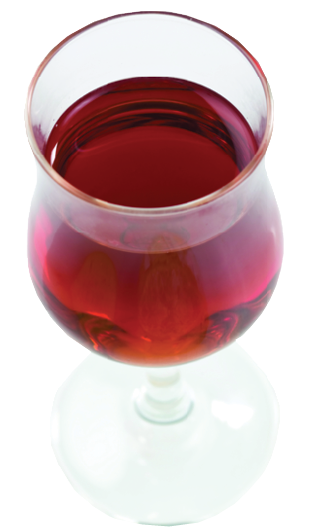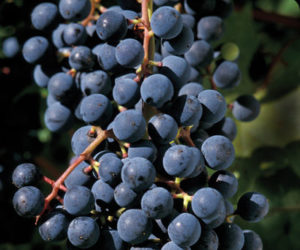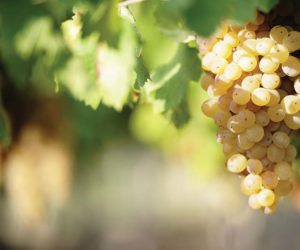
Port, also known as porto, derives its name from the Portuguese city of Oporto, in the Douro Valley, where it originated more than three centuries ago. New World winemaking regions such as California and Australia now replicate their own versions of port. (We will refer to these as port-style wines to differentiate them from authentic port made in Portugal.)
Port is produced from a blend of many different dark-skinned grape varieties, up to 20 or more, often harvested from multiple vineyards, each imparting a different characteristic to the final wine. Dark-skinned grapes are used to give port its deep color. Among these varieties, Touriga Nacional and Tempranillo are the most popular. In New World regions, port-style wines are also made from single grape varieties such as Syrah and Zinfandel. When the desired characteristics or quality cannot be achieved because of a poor vintage, for example, wines from different vintages can be blended to make non-vintage port.

Styles of port
Various port styles exist depending on the oak-aging period, filtering and timing of bottling. The most popular port styles are ruby, tawny, vintage and late-bottled vintage (LBV).
Ruby port is a young, early-drinking port with fruity aromas and a deep ruby color. It is usually a blend of a number of varietals (wines from a single grape variety) from one or more vintages, and matured for a short two- to three-year period in oak barrels. Prior to bottling, ruby port is filtered to minimize bottle sediments and therefore does not require decanting.
Tawny port is vinified much like a ruby port; however, it is matured for a longer time in oak barrels, typically 5-7 years, while “aged tawny” can be aged up to 40 years, for example. Tawny port has a predominantly oak character with less fruit than ruby port but greater aroma and taste complexities, owing to its long sojourn in wood and its controlled micro-oxidation (through the barrel). The extended oak maturation period also causes the wine to become lighter, due to the fining action of the tannins from oak barrels, and to turn to a tawny-brown color.
Vintage port represents the apex of port quality and is unquestionably the choice of port aficionados. It is produced from a blend of the best grapes in a single vintage worthy of the highest quality rating. It is bottled without any filtering following a short two-year maturation period in oak casks, and can then be aged in the bottle for 10, 20, 30 or more years. Vintage port has a very deep-purple color that becomes lighter as it ages, and requires decanting before serving to separate the heavy sediments that have formed at the bottom of the bottle – due to “quick” bottling and no filtering.
Late-bottled vintage (LBV) port is an early-drinking port vinified from grapes from a single vintage not worthy of making vintage port, and bottled 4-6 years following harvest with optional filtering. Filtered LBV port is popular with consumers because it is vintage style but does not require aging or decanting.
Planning your port
Making port-style wine at home is simple if you plan your vinification process. It does not necessarily require the intricate blending or the use of oak barrels as in true port, and it can be vinified from any type of juice. Easy-to-use port winemaking kits are now available to home winemakers wanting to discover port-style wines.
You can make your base wine from concentrate, fresh juice or grapes. Traditional varietals, such as Touriga Nacional or Tempranillo, that are used in port production will be difficult to find. Pick readily-available varietals that once blended will provide typical port-wine characteristics. For example, you can blend Syrah to add tannins and peppery aromas, Merlot to add fruity aromas, and perhaps a little Alicante Bouschet to deepen the color. Blending ratios depend on taste; a typical ratio for these varietals is 75-20-5, respectively. Or you can try a 50-50 blend of Syrah and Zindandel for a fruity, peppery port with more supple tannins.
In true port production, varietals are blended after the brandy is added and each wine is stabilized. This provides the winemaker with better control over the quality of the final blend; however, this can become quite involved and complex in managing for home winemakers. To keep things simple, the juice from each varietal can be blended in the required proportions before start of fermentation, or alternatively, you can use a single varietal, such as Syrah or Zinfandel.
Once you have determined your desired blending strategy, the next steps include establishing the desired final alcohol content (this determines how much brandy to add), figuring out at what point to add brandy to stop fermentation, and deciding on oaking and maturation regimens. Instead of oak barrels, inexpensive and easy-to-use oak chips will be used. Try not to exceed 20% alc/vol to avoid having an overly heady wine.
When using grapes as the source of juice, plan for a short but vigorous maceration of skins in the juice for maximum color extraction. Color is extracted in the first few days of maceration and then extraction quickly drops. Maximum color extraction is best accomplished under warmer temperatures by placing the fermenting vat in a warm area around 68° F (20° C), and letting the fermentation proceed up to 86° F (30° C). Do not let the temperature exceed this maximum to avoid killing the yeast prematurely and ending up with a stuck fermentation. (Refer to “Master Maceration” in the Fall 2001 issue of WineMaker for more information on maceration.)
The instructions provided below are based on a 5-gallon (20-liter) volume of base wine to which brandy will be added to obtain a final alcohol content of approximately 20% alc/vol. We’ll use juice with an initial SG of 1.095 (23.0° Brix), and stop fermentation at approximately 1.035 (9.0° Brix) by adding brandy. Using the potential alcohol content for these SG levels, the base wine will effectively have 12.7-4.4 or 8.3% alc/vol, or 8% for simplicity, with just over 100 g/L of residual sugar. Fermentation of commercial port is stopped at a higher SG for a sweeter wine, but requires considerably more brandy volume to achieve the desired final alcohol content.
Your best guide to determine the desired amount of residual sugar is by taste. You can always adjust the sweetness level at the final stage. If you prefer to quantify the amount of residual sugar, you can use Clinitest tablets used for measuring glucose content in urine. (Refer to “How Sweet It Is” in the April-May 2002 issue of WineMaker for more information on measuring and adjusting sweetness.)
Use the Pearson Square (see sidebar) to determine the volume of brandy required to increase the alcohol content of the base wine from 8% to 20% for the port. Your 5-gallon (20-liter) batch of base wine will require 3 gallons (12 liters) of brandy to bring the alcohol level to 20%. The total port yield will therefore be approximately 8 gallons (32 liters), or 42 bottles. With this amount of brandy, you will want to seek the most inexpensive type. The quality of the brandy is not what determines the quality of the port; rather, the quality of the juice used in the base wine and vinification methods are critical. If you want to reduce the amount of brandy and settle for lower alcohol content, you will need 2.4 gallons (9 liters) to get an 18% port.
Lastly, our objective will be to produce an early-drinking ruby-style port wine by imparting oak flavors and aromas using oak chips. The wine will be fined by natural sedimentation (no fining agents and optional filtering).
Making your port
Sanitize all your equipment with a sulfite solution. Pour the juice into a 6-gallon (23-liter) pail to the 5-gallon (20-liter) level, and stir thoroughly. The larger-volume pail is to allow for foaming during fermentation. Place the pail in an area that will allow the juice to reach a temperature between 63° and 68° F (17° and 20° C) to ensure a good fermentation, especially if your juice is cold. Use a floating thermometer to monitor the temperature of the juice.
Measure the initial SG and, if required, adjust to 1.095 by adding 17 g/L of corn or cane sugar for every 0.008 increase in SG. For example, if the initial SG is 1.087, add 340 g (17 g/L x 20 L) or 12 oz of sugar to the 5-gallon volume of juice. Dissolve 2 tsp (10 mL) of grape tannin powder in warm water, add to the juice, and stir very well.
Prepare 3 ounces (80 g) of medium-toast oak chips by first rinsing them in a sieve under running cool tap water until no more dust or color is being washed out. If the chips are not toasted, simply toast them in a small conventional toaster-oven at 400° F (200° C) until most are browned but not burnt. Drop the cooled chips loosely in the juice.
Inoculate the juice with a packet of your favorite yeast fermenter, such as Lalvin’s RC-212 or Red Star’s Pasteur Red strains, which are ideal for full-bodied, tannic wines in which complex aromas are desired. Loosely place the lid on the pail to let carbon dioxide gas escape during fermentation.
Fermentation will start within 24 to 32 hours. Stir the fermenting juice once daily, and monitor the SG drop with your hydrometer on a daily basis. When the SG reaches 1.035, add the entire volume of brandy to the wine to stop fermentation, and stir thoroughly. Let the wine stand for one week to allow solids to precipitate to the bottom of the pail.
Rack the port into a clean and sanitized glass fermenter while allowing the wine to splash at the bottom. Taste the wine and, if you need to adjust the oak level, re-add the chips to the racked wine, and let stand another week or two until the desired oak level is achieved. Be sure to top up the fermenter and secure it with a rubber bung and fermentation lock. Although sulfite is not required to protect the wine against oxidation because the brandy effectively accomplishes this, I still prefer to add approximately 25 mg/L (1/4 teaspoon), or 3 Campden tablets, for added security.
Age the port for 6 months in the carboy while racking every two months to separate the sediments without the need for fining. Fining is not required since the brandy acts as a clarifying agent. Optionally, it may be clarified with gelatin or coarse-filtered using No. 2 pads prior to bottling. You may also adjust the sweetness to your taste before bottling by adding corn sugar or a wine conditioner.
Note: Sorbate cannot be used to stop an active fermentation. Sorbate is only used in preventing renewed fermentation in sweet wines. It is not required in port because the high alcohol level already prevents any potential renewed fermentation in the bottle.
If blending different varietals, experiment with different blends and ratios until you establish a combination you like. Blend the batches of port according to the desired ratio, bulk-age the wine for a couple of months before re-tasting, and make any necessary adjustments to the blend.
Port may be bottled in typical port-style bottles or any bottle type of choice. Port and other fortified-wine bottles are corked using a regular cork driven by a hand or floor corker. If you wish to keep with tradition like true port aficionados, use stopper-type corks; these are shorter corks with a plastic stopper. Stopper-type corks, available in 3/4-inch (19-mm) lengths, have the same properties as regular corks but need to be inserted in the bottle by hand instead of using a corker. They need to be sanitized by soaking in a sulfite solution for 15 minutes.
This port-style wine will last a few years, so don’t hold back your production. Your family and friends will also be impressed by the quality.




